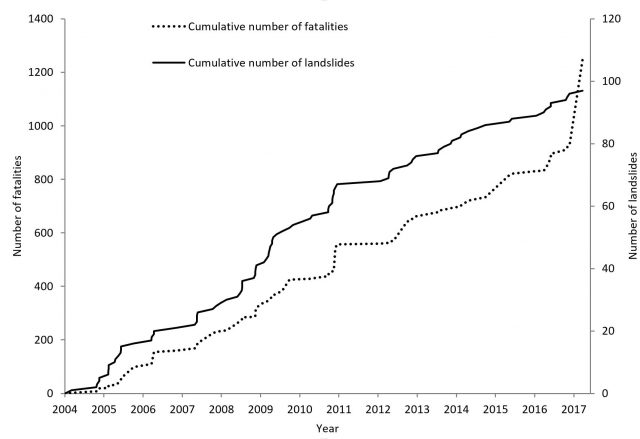19 April 2017
Losses from landslides in Colombia: the long term picture
Posted by Dave Petley
Losses from landslides in Colombia: the long term picture
News is coming in today of further landslides in Colombia, with at least 14 reported fatalities in Manizales, where it is reported that at least 50 landslides have been triggered by up to 156 mm of rainfall. Some reports suggest that a further 23 people may be missing. This comes on top of the recent Mocoa landslide, in which at least 300 people were killed.
Back in 2012 I posted about landslide losses in Colombia, noting that:-
If we are to reduce the impact of landslides across South America then Colombia needs to be a priority country.
In 2015 Sergio Sepulveda and I analysed landslides in Latin America in a paper that was published in Natural Hazards and Earth System Sciences. The paper is open access, so it is free to download. I posted a summary of the paper at the time. In that paper we also noted that landslides inflict a heavy toll in Colombia.
Of course in the almost five years since my 2012 post, Colombia has gone through considerable change, including the end of the conflict between FARC and the government. This is therefore a timely moment to take another look at landslide losses there.
The graph below shows the cumulative total number of landslides and landslide fatalities in Colombia, based on my long term landslide fatality database. Note that the data only records landslides that cause loss of life. This does not include the landslides in the last 24 hours in Mazinales.

Cumulative losses from landslides in Colombia since 2004, based on my landslide fatality dataset
.
Sadly, the data suggests that there is no sign that losses from landslides in Colombia are reducing, and it is clear that the cost of landslides in Colombia is high. The good news is that they do not seem to be getting worse either, although the recent losses are clearly the worst since I started to collect this data in 2004.
In my post in 2012 I noted that rainfall in Colombia is heavily affected by the ENSO cycle. Interestingly, the large El Nino of 2014-15 did not drive an increase in landslide losses. However, the rainfall events that the country is currently experiencing are being ascribed to a “coastal El Nino” event. This is not a term that I have heard before; it will be interesting to see if this scientifically valid, and if so if it might provide greater insight into the variable triggers of landslides in South America.


 Dave Petley is the Vice-Chancellor of the University of Hull in the United Kingdom. His blog provides commentary and analysis of landslide events occurring worldwide, including the landslides themselves, latest research, and conferences and meetings.
Dave Petley is the Vice-Chancellor of the University of Hull in the United Kingdom. His blog provides commentary and analysis of landslide events occurring worldwide, including the landslides themselves, latest research, and conferences and meetings.
Thanks for posting this research data you have. Used to live in Colombia for a spell… so what happened in 2004? Heheheheh.
Please delete last comment. Answered my own question…your data collections started in 2004.